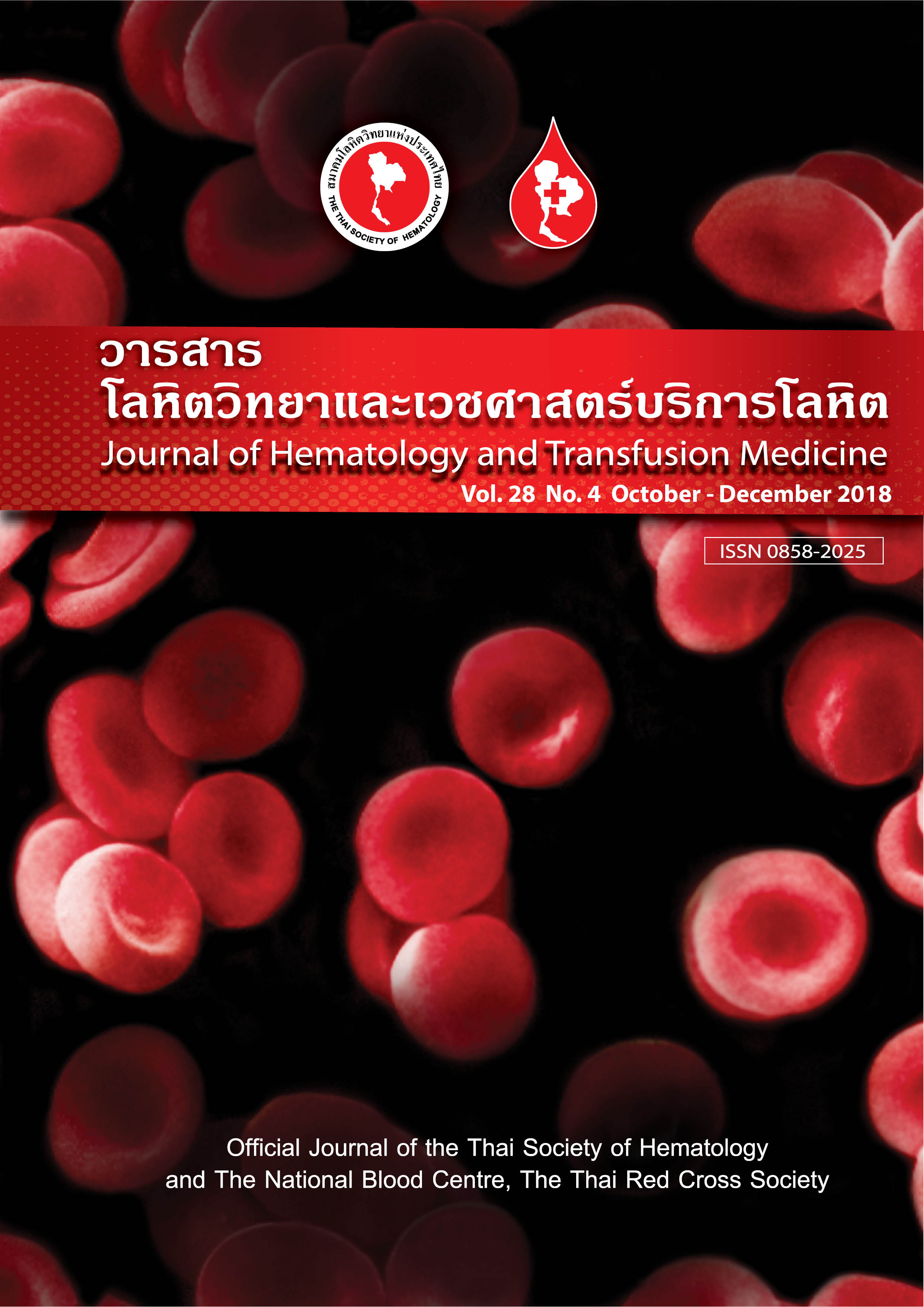Factors Associated with Mortality Outcomes of Patients with Disseminated Intravascular Coagulation resulting from Septicemia: A Single Center
Keywords:
Disseminated Intravascular Coagulation (DIC), Coagulopathy, Septicemia, Red Blood Cell Transfusion, Cryoprecipitate TransfusionAbstract
Background: Disseminated intravascular coagulation (DIC) acquired from sepsis is a life-threatening condition which results in high mortality rates. The basic knowledge of epidemiology and the related factors causing morbidity and mortality can help physicians to recognize symptoms as well as provide proper management to decrease death rates. Objective: The aim of the study was to determine prevalence of DIC among patients with septicemia and factors associated with mortality outcomes. Materials and Methods: The medical records of 205 septic patients from 2011 to 2015 at HRH Princess Maha Chakri Sirindhorn Medical Center were gathered, reviewed, and analyzed as a retrospective study. Results: According to information obtained from 205 medical records, the median age of the patients was 68 years (range, 20-104). One-hundred and four patients were female (50.7%) and 101 patients (49.3%) were males. The blood cultures were positive for bacteria in 68.80% of cases. Urinary tract infection was the most common followed in rank by those of the respiratory tract, intra-abdominal area, skin and central nervous system. Thirty-nine of the 205 patients (19.0%) developed DIC. Multivariate analyses revealed significant associations with mortality within 28 days of hospital admission for patients presenting stage 4 chronic kidney disease (CKD) (p = 0.002), simple DIC score ≥ 2 at; diagnosis (p = 0.019) and 28 days of hospitalization (p < 0.001). Seventeen patients of the 39 (43.6%) diagnosed with DIC expired. Conclusion: A high mortality rate was observed among patients who developed sepsis with concurrent DIC. Patients presenting CKD stage 4, high level of simple DIC score at admission or 28 days of hospitalization were associated with higher mortality outcomes.
Downloads
References
2. Wada H. Disseminated intravascular coagulation. Clin Chim Acta. 2004;344:13-21.
3. Wada H, Matsumoto T, Yamashita Y. Diagnosis and treatment of disseminated intravascular coagulation (DIC) according to four DIC guidelines. J Intensive Care. 2014;2:15.
4. Oppenheimer L, Hryniuk WM, Bishop AJ. Thrombocytopenia in severe bacterial infections. J Surg Res. 1976;20:211-4.
5. Beller FK, Douglas GW. Thrombocytopenia indicating gram-negative infection and endotoxemia. Obstet Gynecol. 1973;41:521-4.
6. Mayne ES, Mayne ALH, Louw SJ. Pathogenic factors associated with development of disseminated intravascular coagulopathy (DIC) in a tertiary academic hospital in South Africa. PloS One. 2018;13:e0195793.
7. Kawasugi K, Wada H, Hatada T, Okamoto K, Uchiyama T, Kushimoto S, et al. Prospective evaluation of hemostatic abnormalities in overt DIC due to various underlying diseases. Thromb Res.2011;128:186-90.
8. Mahanupap P, Angchaisuksiri P, Rattanasiri S. Disseminated Intravascular Coagulation in Ramathibodi Hospital. J Hematol Transfus Med. 2010;1:27-38.
9. Seki Y, Wada H, Kawasugi K, Okamoto K, Uchiyama T, Kushimoto S, et al. A prospective analysis of disseminated intravascular coagulation in patients with infections. Intern Med (Tokyo, Japan). 2013;52:1893-8.
10. Kienast J, Juers M, Wiedermann CJ, Hoffmann JN, Ostermann H, Strauss R, et al. Treatment effects of high-dose antithrombin without concomitant heparin in patients with severe sepsis with or without disseminated intravascular coagulation. J Thromb Haemost. 2006;4:90-7.
11. Dhainaut JF, Yan SB, Joyce DE, Pettila V, Basson B, Brandt JT, et al. Treatment effects of drotrecogin alfa (activated) in patients with severe sepsis with or without overt disseminated intravascular coagulation. J Thromb Haemost. 2004;2:1924-33.
12. Kelm DJ, Valerio-Rojas JC, Cabello-Garza J, Gajic O, Cartin-Ceba R. Predictors of Disseminated Intravascular Coagulation in Patients with Septic Shock. ISRN Critical Care. 2013;2013:6.
13. Fei A, Lin Q, Liu J, Wang F, Wang H, Pan S. The relationship between coagulation abnormality and mortality in ICU patients:a prospective, observational study. Sci Rep. 2015;5:9391.
14. Oh D, Jang MJ, Lee SJ, Chong SY, Kang MS, Wada H. Evaluation of modified non-overt DIC criteria on the prediction of poor outcome in patients with sepsis. Thromb Res. 2010;126:18-23.
15. Kinasewitz GT, Zein JG, Lee GL, Nazir SA, Taylor FB, Jr. Prognostic value of a simple evolving disseminated intravascular coagulation score in patients with severe sepsis. Crit Care Med. 2005;33:2214-21.
16. Levi M, Toh CH, Thachil J, Watson HG. Guidelines for the diagnosis and management of disseminated intravascular coagulation. British Committee for Standards in Haematology. Br J Haematol. 2009;145:24-33.
17. Spero JA, Lewis JH, Hasiba U. Disseminated intravascular coagulation. Findings in 346 patients. Thromb Haemost. 1980;43:28-33.
18. Makruasi N. Treatment of Disseminated Intravascular Coagulation. J Med Assoc Thai. 2015;98(Suppl 10):S45-51.
19. Lever A, Mackenzie I. Sepsis: definition, epidemiology, and diagnosis. BMJ (Clinical research ed). 2007;335:879-83.
20. Iba T, Di Nisio M, Thachil J, Wada H, Asakura H, Sato K, et al. A Proposal of the Modification of Japanese Society on Thrombosis and Hemostasis (JSTH) Disseminated Intravascular Coagulation (DIC) Diagnostic Criteria for Sepsis-Associated DIC. Clin Appl Thromb Hemost. 2018;24:439-45.
21. Goswami J, Balwani MR, Kute V, Gumber M, Patel M, Godhani U. Scoring systems and outcome of chronic kidney disease patients admitted in intensive care units. Saudi J Kidney Dis Transpl. 2018;29:310-7.
22. Juneja D, Prabhu MV, Gopal PB, Mohan S, Sridhar G, Nayak KS. Outcome of Patients with End Stage Renal Disease Admitted to an Intensive Care Unit in India. Ren Fail. 2010;32:69-73.
23. Dara SI, Afessa B, Bajwa AA, Albright RC. Outcome of patients with end-stage renal disease admitted to the intensive care unit. Mayo Clinic Proceedings. 2004;79:1385-90.
24. Walcher A, Faubel S, Keniston A, Dennen P. In: critically ill patients requiring CRRT, AKI is associated with increased respiratory failure and death versus ESRD. Ren Fail. 2011;33:935-42.



